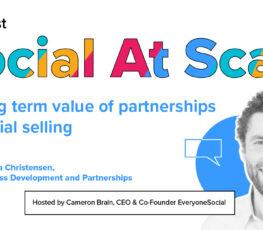Social Selling Defined, Why It Matters, & Much More
Social selling has been around for a few years now, yet many people and companies get confused about this strategy.
In order for your organization to become social experts and reap the benefits, we put together this in-depth article on everything your company should know.
Below you’ll find the following topics covered:
- What is Social Selling? The Definition
- Social Selling Mechanics
- Is Social Selling Marketing or Selling?
- LinkedIn’s 4 Pillars of Social Selling
- The Challenges of Social Selling
- Social Selling Statistics
What is Social Selling?
Social selling is about leveraging your social networks to find the right prospects, to build trusted relationships, and ultimately, to help you achieve your sales goals by answering prospect questions and offering thoughtful content until the prospect is ready to buy.
You’ve probably even heard the term ‘social selling’ in some capacity. Maybe you sat up a little straighter, thinking you ‘get it’ or maybe you nodded your head in silence when your manager told you to optimize your strategy.
The term gets thrown around in a lot of meetings but like many evolving trends and roles in the workplace (remember when influencer marketing was a newcomer?), it’s often misunderstood.
But social selling is here to stay, and it’s core to your business operations and ultimately, your company’s success.
To do it well, you have to have a deep understanding of how it works — and accept that it’s not ‘owned’ by one department in your organization. In fact, social selling is — much like a lot of successful business initiatives — a team effort.
Let’s debunk the myths and clear up any confusion about what social selling is — and why more companies need to have a strategy and program in place.

Social Selling Simple Mechanics
The concept is very similar to that of inbound marketing, which HubSpot pioneered back in 2006: the goal is to improve overall sales and marketing efficiency by building more substantive relationships with target audiences.
To break it down, this is how social selling works:
- Rather than spending time on cold, outbound prospecting, you focus on generating conversations and engagement throughout the sales process.
- Your sales team members participate in social media, share interesting content, and build relationships organically — over time.
- As an organization, you can encourage sales reps to share a mix of branded and non-branded content so that they become perceived as expert curators.
- Over time, the visibility that your sales reps bring via the content that they’re collectively sharing trickle back to your organization as a whole.
In a nutshell, social selling is the process of using tools like Facebook, Twitter, and LinkedIn to:
- create relationships
- define your reputation
- gain visibility among your target market
- deliver value to your target market
- establish credibility.
The more present a salesperson is, the more relationships that he or she will build. The less you sell, and the more you focus on delivering value, the more than your book of business will grow.
Plus, social selling is important because it positively influences these marketing metrics:
Referral traffic: Web visitors who come to your website through social media. This metric tells you that your content is generating awareness on social media.
Direct traffic: Audiences who visit your website by typing your URL into your browser. This metric tells you that your brand is memorable.
Net promoter score: This metric measures loyalty between brands and their customers. This metric is based on the direct question – “How likely is it that you would recommend our company/product/service to a friend or colleague?”
Exposure to new audiences: Content will quickly become your brand’s engine for growth. An advocacy marketing program can help your business uncover new customer acquisition and conversation channels.
Additionally, social selling should also influence the following sales metrics: sales revenue, appointments, social network metrics, and social influencer scores.

Is Social Selling Marketing or Selling?
A lot of people think that social marketing and social selling are interchangeable but the distinction is an important one if you are to understand how to optimize your strategies (both for social marketing and social selling).
Unlike social marketing, social selling is aimed at cultivating one-on-one relationships vs. broadcasting to many.
And while Wikipedia will tell you that it is primarily aimed at sales professionals in your organization as opposed to your marketing department, folks like Symantec’s Sr. Director of Digital Marketing, Charlie Treadwell, would argue that it actually applies to anyone in your organization who has one-on-one communication with a prospective customer.
Of course, this group includes marketing. That’s where the real confusion sets in.
Treadwell says social selling is “about providing information, connecting, discussing and creating trust in a way that builds relationships and shared value” — something marketing and sales frequently do well, together.
Sales have the relationships and the expertise in ‘selling’ but marketing is often on the frontlines of the brand value proposition, the story, and the tools needed to measure and optimize these interactions.
It might be called social but it’s actually pretty personal
Part of the reason there’s so much disagreement around what social selling is and who owns it lies in the name itself, a misnomer, many would argue. Social selling is in some ways neither social nor selling — at least not on the surface.
It isn’t about closing the deal, even though that’s certainly a goal of your sales organization. Nor is it about every conversation happening on a social network — or even online. Even though, of course, many of the conversations you have with your customers have long been happening in the social sphere.
In an interview with Inc., social selling expert Mario Martinez Jr. advises that “your goal is to take every online conversation to offline.”
By definition, it isn’t conventional selling — it sits at the intersection of sales, marketing, online, and offline worlds.
At its core though, it’s aimed at delivering value to a potential contact, influencer, and customer in the right place, at the right time through personal relationships.
Here’s how Kissmetrics defines social selling, at a glance:
- Endorsing a customer on LinkedIn.
- Running LinkedIn searches for outbound targets
- Liking a client’s Facebook post.
- Sharing the company’s latest blog post on Twitter, LinkedIn, Facebook and Google+.
- Studying prospects on LinkedIn and Twitter before a meeting.
- Following key accounts on Twitter.
- Retweeting a client.
Social selling is not:
- Delivering the hard sell on LinkedIn.
- Closing deals on Twitter.
- A replacement for talking to prospects.
- A magic bullet for making quota.
So, who owns social selling in an organization?
Ultimately, it makes the most sense for your sales team to ‘own’ from a distribution perspective — these are the people who have forged personal relationships with prospects and customers and who are likely maintaining those relationships.
But increasingly, your marketing team will likely play a supporting role.
The marketers in your organization can help craft messaging that will resonate and feed your sales team quality content (both branded and non-branded) that they can then share one-on-one with their connections.
With all these complex definitions floating out there, it’s no wonder there’s so much confusion about what it is in practice. The next time it comes up in conversation, remember these three simple things:
- It is personal: one-on-one vs. one-to-many.
- It’s about building trusting, long-term relationships, not making ‘the sell.’
- It’s about leveraging the tools, technologies, and people in your organization to deliver value to your customers.
Most importantly, it’s neither social or selling.

LinkedIn’s 4 Pillars of Social Selling
LinkedIn, a company that is undeniably at the forefront of the social selling movement, recommends that all professionals involved in social selling adhere to the following 4 pillars:
- Create a strong professional brand to increase your visibility to your desired contacts and build trust in your industry.
- Don’t just blanket the world with your pitch. Instead, focus on the best prospects for your industry, and your goals.
- Establish yourself as a subject matter expert/thought leader to show that you’re an informer, not a me-former. Regularly share interesting industry content, engage with stories shared in your field, and limit how much you promote yourself over others.
- Start with genuine conversation. If your prospects feel like they’re immediately being sold to, they’ll be less likely to want to build a relationship with you. Remember: the selling comes after the social in social selling.
It’s all about the 2 Cs
Regardless of what you’ve heard about this concept, it really boils down to two things: connections and content.
Personal branding expert Dan Schawbel told Forbes that “social selling success is comprised of both making new connections and sharing great content.
You start by identifying your target audience and connecting with their network of influencers.”
And he’s not talking about overly-promotional branded content that you’ll often find blanketing your Facebook, LinkedIn, and Twitter feeds. He’s referring to content that makes salespeople great storytellers that add value to their personal connections.
The challenges of Social Selling
You’re probably thinking “yes, social selling is awesome, and yes, my company needs to do this yesterday.”
Unfortunately, the general industry trend is such that companies, no matter how well-intentioned they might be, are having trouble launching successful social selling programs.
Cold-pitching and outbound prospecting, naturally, feels like the ‘right’ way to do things because the path from pitch to sale is extremely direct.
Social media, on the other hand, has traditionally been thought of as a waste of time.
The biggest challenge of social selling is that it requires cross-functional collaboration.
To navigate the shift, you need support from marketing and technology teams to make sure that sales teams have the right infrastructure in place to find great content and track how that content performs.
Even more importantly, teams need a clear set of tools and processes to get up and running.
For this reason, organizational change needs to happen at the management and executive levels, with company leaders revisiting the metrics, processes, and goals that they set for their teams. It’s not enough to tell your sales teams to ‘tweet more.’
Team members need a support system to:
- discover great content
- share content easily
- follow up on conversations
- measure the results of their social media activity.
Related: Want to learn how Genesys achieved a 22% increase in won opportunities and improved their deal size by 165% with a social selling program? Download this case study to learn their strategy and more.
Social Selling Statistics
To truly get a sense of why social selling is important, it is crucial to showcase information backed by data. Below are a few stand-out social selling stats that are valuable to know.
Just note, these are only scratching the surface. There are hundreds of interesting stats online.
- Sales reps using social media as part of their sales techniques outsell 78% of their peers (Source)
- 77% of B2B buyers said they did not talk with a salesperson until after they had performed independent research (Source)
- 46% of individual social sellers hit quota compared to 38% of sales reps who don’t (Source)
- 64% of teams that use social selling hit quota compared to 49% that don’t (Source)
- 53% of salespeople want help in understanding social selling better (Source)
- Companies with consistent social selling processes are 40% more likely to hit revenue goals than non-social sellers (Source)
- 31% of B2B professionals said that social selling allowed them to build deeper relationships with their clients (Source)
- 90% of decision-makers never answer a cold call, but 75% of B2B buyers use social media to make purchasing decisions (Source)
Final Thoughts
Hopefully, throughout this post, you learned what social selling is, why it matters, some challenges, and got some valuable social selling tips.
One thing that is important to note: social selling is a never-ending experiment.
With every message that you publish on social media, you create a new opportunity to test out content and discussion points.
What’s resonating? What isn’t capturing your audience’s attention spans, and why?
Over time, your social selling strategy will help you answer these questions.
And once you do, you’ll have tested and data-driven perspectives to inform your sales strategy moving forward. The end result will be higher close rates and stronger long-term relationships.
The idea is simple: make every digital interaction count, and you’ll see the results in your overall sales.















